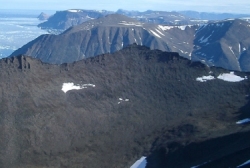
September Editorial
Primordial terrestrial mantle reservoir found on the Baffin Island.

September Editorial
Primordial terrestrial mantle reservoir found on the Baffin Island.
|
Baffin Island in Nunavut in northern Canada has some unique rocks. These rocks contain no special ores or chemicals, but they are very, very old. According to recent research these rocks come from the primordial mantle and are just slightly younger than the Earth itself.
|
Earlier studies of those rocks have shown that they have a high helium-3 (H3)\helium-4 (H4) ratio. These helium isotopes are very powerful indicators of primitive material in the Earth’s mantle. As volcanoes erupt they release a molten mixture from the mantle which contains both H3 and H4. Both helium isotopes escape into the air. When the lava cools into rock the H4 is slowly replenished by the radioactive decay of elements such as, for example, uranium. However, this is not the case with H3. |
So over time if rocks are pushed down below the surface of the Earth’s crust, melted and brought back to the surface during the next volcanic eruption, this process will reduce the amount of H3 and increase the amount of H4. So the ratio of H3 to H4 in the rocks will be lower. Therefore the higher the ratio of H3 to H4 in a rock, the older and closer to the original it is. The Baffin Island rocks have a very high ratio of H3/H4. This has caused some researchers to claim that these basalts are part of the primordial terrestrial reservoir preserved in the mantle from the time it was created - some 4.5 billion years ago.
Matthew G. Jackson, Richard W. Carlson, the leading author of a recent Nature paper, has shown that in addition to the high H3/H4 ratio, the Baffin Island rocks have primitive lead-isotope ratios consistent with an ancient mantle source from 4.55-4.45 billion years ago. To study the the composition of the rocks and the primitive lead levels, the researchers used uranium-thorium (U-TH) and uranium-lead (U-Pb) dating techniques.
By estimating the thorium-230/uranium-234 ratio in the sample, it proved possible to estimate how long the sample had been within the Earth's crust. The U-Pb dating looks at the end product of decay, which is Pb-207 and Pb-208. The primordial level of lead can also be established by estimating Pb-204, the only isotope of lead which is not the result of radioactive decay.
By combining all the measurements, Carlson and his co-workers could show the exact age of the rocks. The research also revealed something unexpected. The composition of the rocks was not completely what the scientists expected to find when comparing their data with previous research on mantle composition. The most accepted theory of the primitive composition of the Earth’s mantle is that it originally had the same composition as meteorites. In most studies of the earth’s mantle the data is assumed to correlate with what we know from studies of meteorites. However, in this case Carlson and his co-workers found that the Baffin Island rocks have much less uranium and thorium than expected.
But levels of U,Th, and Pb can sometimes be slightly inaccurate due to the influence of changing conditions in the Earth’s crust. So Carlson and his colleagues went further and estimated the levels of two rare elements: samarium (Sm) and neodymium (Nd). Sm-Nd dating is useful because those two elements are rare earths which means that they (unlike Pb) are affected only minimally by weathering. Sm-Nd dating is based on the decay of a long-lived Sm147 isotope to the Nd-143 isotope. This method is often used to study the age of both Earth rocks and meteorites, as Nd isotope ratios provide information on the source of rocks as well as age data. The various reservoirs within the solid earth have different initial values of 143Nd/144Nd ratios; especially with reference to the mantle.
Taking all the data together allowed Carlson and his colleagues to show that the Baffin Island rocks are made from the primitive mantle (the most ancient accessible reservoir on the Earth’s mantle). This may be the parent of all mantle reservoirs that give rise to modern volcanism. But the research also showed that the composition of the primordial mantle may have been somewhat different to the composition of meteorites.
Reference
Matthew G. Jackson, Richard W. Carlson, Mark D. Kurz, Pamela D. Kempton, Don Francis & Jerzy Blusztajn. Evidence for the survival of the oldest terrestrial mantle reservoir. (2010) Nature 466, 853-856.
| _______________________________ | ||||
| Home | | | Shopping | | | Database |
© Biscuit Software 2004-2015
All rights reserved